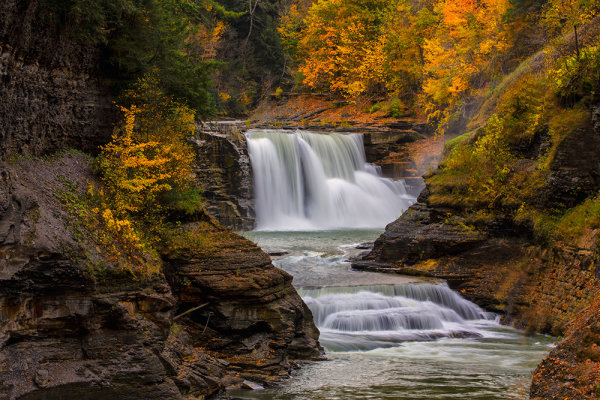
For this image of Lower Falls in Letchworth State Park in New York, I knew I wanted a creamy look to the falls. They were flowing well so I knew a moderately slow shutter speed would give me what I wanted. I also knew as I composed it that I wanted the falls framed by some of the gorgeous colors of the fall foliage. I set my exposure based on two things- I wanted a slow shutter speed and I wanted deep depth of field. EOS 5D Mark III, EF 70-300 f/4-5.6L, ISO 100, f/25, .3″.
A good friend of mine is passionate about photography, and she recently acquired a reminder of the way she approaches photography. A tattoo that wraps around her bicep that states simply “Shoot With Intent”. This is one of the biggest lessons a beginning photographer can learn. It’s very easy to go out with a camera, set it on AUTO, and come back with some nice, perhaps even great images. Today’s cameras make that fairly easy, even without shooting on full auto. If you’re using aperture priority or shutter priority, just allowing the camera to come up with an correct exposure, you can still great images without considering all aspects of the exposure. However, without considering all aspects of the exposure and allowing the camera to make decisions for you, you’re not really shooting with intent.

I wanted to capture this image of trees reflected in the Merced, but the water was undulating just enough to cause problems with the reflection. A slower shutter speed helped smooth the ripples and give me a better reflection. EOS 5D Mark III, EF 70-300 f/4-5.6L, ISO 100, f/16, .3″.
Shooting with intent means you take into consideration all aspects of the image you’re creating. It starts with the lens you choose to put on your DSLR and carries all the way from subject and composition, to shutter speed, ISO, and aperture, you think through every aspect of the shot, and how those variables will affect the image. Let’s assume you’ve chosen a lens, a subject, and decided how you want to compose the image, since those are the two most basic aspects of creating an image. You look through the viewfinder, or on the LCD screen, and you decide where things should go in the frame. That’s about half of the decisions you need to make right there.
Next, you need to consider the three aspects of exposure- aperture, shutter speed, and ISO. This is a balancing act where you need to prioritize what’s most important to you. Take your aperture. Let’s say you’ve decided you want everything in focus. You’ll want to select a smaller aperture, say, f/11 or even f/16 to provide the greatest depth of field. But then what about your shutter speed? If you’re in Aperture Priority mode, the camera will figure that out for you. But if there’s something moving in the shot- trees blowing in the wind, a waterfall, or waves on the ocean, or even people- is that something you want to just leave to the camera?
You can still be in Aperture Priority and pay attention to your shutter speed. Let’s assume you’re shooting a water feature. If you want smooth, misty water, you’ll know you need a slower shutter speed. But how slow? That depends on what the water is doing, and on how you want the water to look. That’s where your INTENT comes in. If you still want some definition in the water, you’ll want a slightly faster shutter speed that allows for that. How fast depends on how fast the water is moving. If you want that milky look to the water, you’ll want a slower shutter speed. Again, how slow depends on the water’s movement.
The point is, before just allowing the camera to set the shutter speed, or the aperture, or anything else, regardless of what mode you’re in, figure out what it is you really want out of this capture. Decide what your intent is, and double check what the camera is doing to be sure that your intent is carried through. And if it isn’t? Change it.
Make sure your images say what you meant to say. Be sure your intent is clear.
Post originally from: Digital Photography Tips.
Check out our more Photography Tips at Photography Tips for Beginners, Portrait Photography Tips and Wedding Photography Tips.
Shooting With Intent
You must be logged in to post a comment.